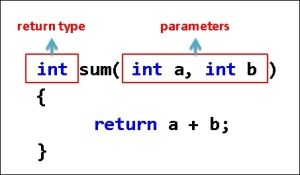An example of a function that returns a value is the sqrt() function. The sqrt() function accepts a single parameter between its brackets (the number to root) and returns the actual root of the number.
Here's an example usage of the sqrt function:
cout << sqrt( 4 ) << endl;
The sqrt() function does something analogous to what the chef did when preparing the pizzas.
As a caller of the function, you do not care about what goes on inside the body of the sqrt() function; that information is irrelevant since all you want is the result of the square root of the number that you are passing.
Let's declare our own simple function that returns a value, as shown in the following code:
int sum(int a, int b)
{
return a + b;
}The following screenshot shows the anatomy of a function with parameters and a returned value:

The sum function is very basic. All it does is take two int numbers a and b, sums them up together, and returns a result. You might say that we don't even need an entire function just to add two numbers. You're right, but bear with me for a moment. We will use this simple function to explain the concept of returned values.
You will use the sum function in this way (from main()):
int sum( int a, int b )
{
return a + b;
}
int main()
{
cout << "The sum of 5 and 6 is " << sum( 5,6 ) << endl;
}For the cout command to complete, the sum( 5,6 ) function call must be evaluated. At the point where the sum( 5,6 ) function call occurs, the returned value from sum( 5,6 ) is put right there.
In other words, this is the line of code that cout actually sees after evaluating the sum( 5,6 ) function call:
cout << "The sum of 5 and 6 is " << 11 << endl;
The returned value from sum( 5,6 ) is effectively cut and pasted at the point of the function call.
A value must always be returned by a function that promises to do so (if the return type of the function is anything other than void).
- Write an
isPositivefunction that returnstruewhen the double parameter passed to it is indeed positive. - Complete the following function definition:
// function returns true when the magnitude of 'a' // is equal to the magnitude of 'b' (absolute value) bool absEqual(int a, int b){ // to complete this exercise, try to not use // cmath library functions } - Write a
getGrade()function that accepts an integer value (marks out of 100) and returns the grade (either A, B, C, D, or F). - A mathematical function is of the form
f(x) = 3x + 4. Write a C++ function that returns values forf(x).
- The
isPositivefunction accepts a double parameter and returns a boolean value:bool isPositive( double value ) { return value > 0; } - The following is the completed
absEqualfunction:bool absEqual( int a, int b ) { // Make a and b positive if( a < 0 ) a = -a; if( b < 0 ) b = -b; // now since they're both +ve, // we just have to compare equality of a and b together return a == b; } - The
getGrade()function is given in the following code:char getGrade( int grade ) { if( grade >= 80 ) return 'A'; else if( grade >= 70 ) return 'B'; else if( grade >= 60 ) return 'C'; else if( grade >= 50 ) return 'D'; else return 'F'; } - This program is a simple one that should entertain you. The origin of the
namefunction in C++ actually came from the math world, as shown in the following code:double f( double x ) { return 3*x + 4; }
